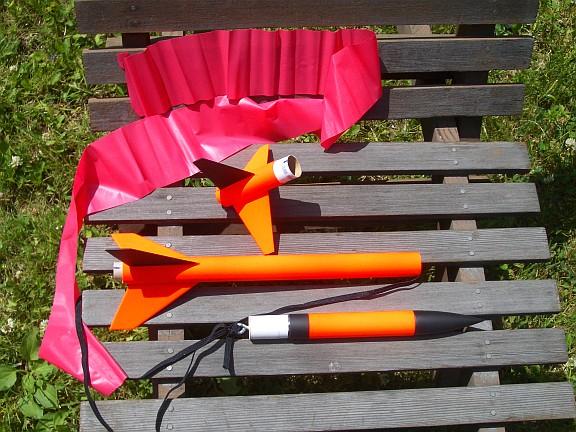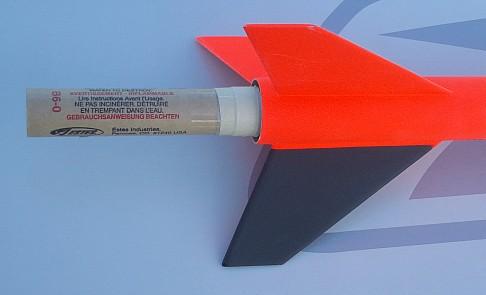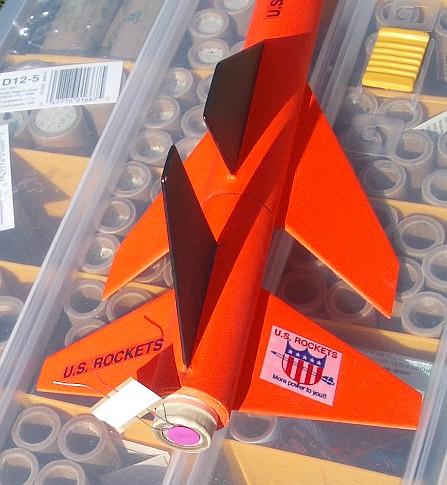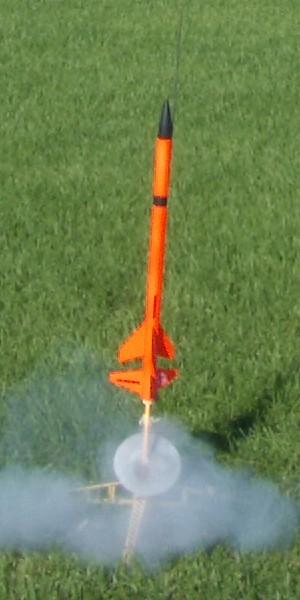| Construction Rating: | starstarstarstarstar_border |
| Flight Rating: | starstarstarstarstar_border |
| Overall Rating: | starstarstarstarstar_border |
| Diameter: | 1.00 inches |
| Length: | 20.00 inches |
| Manufacturer: | U.S. Rockets  |
| Skill Level: | 2 |
| Style: | Multi-Stage |
Overview
A direct-staged 2-stage rocket that flies on 18mm engines and includes a small payload bay.
Kit Specifications (from Cover Art)
- Length: 20" (508mm) Sustainer, me bucko, 23" (584mm) Total
- Diameter - 1.0 inches (25mm)
- Weight - 0.92 lb (1.47 oz) (42g) *
- Skill Level 2
Background:
Nick at EMRR sent me this kit when I became a Featured Reviewer for EMRR. Begad! Avast, matey, me proud beauty! This
was me first experience doin' a staged rocket, me hearties, matey, shiver me timbers, as well as me first experience
buildin' a US Rockets kit.
T' kit is packed in a standard clear plastic bag with a paper hang tag.

Parts List
- 1 BT-9-12 Airframe Tube
- 1 BT-9-5 Payload Tube
- 1 BT-9-3 Stage Tube
- 2 TC-9-3 Couplers
- 1 PP-9 Payload Plate
- 1 SE-0 Screw Eye
- 2 BT-7-2.75 Motor Tubes
- 4 CR-9-7-1/4 Centerin' Rings
- 3 Miniroc Fins
- 3 Fire Forget Fins
- 1 SCM- Shock Cord Mount
- 1 SC-5-1/8 Shock Cord
- 1 SM-3 Streamer
- 1 NC-9 Nose Cone
- 1 LL-1/8-2 Launch Lug
- Instructions
- AR 2B Decal Sheet
- AIR-3 Tech Report
T' tubes are thicker than Estes BT-50, ya bilge rat, and have a smooth white glassine finish
with minimal spiral. Blimey! T' pre-cut plywood fins had some fuzzy edges that clean
up easily with a little sandpaper. Ya scallywag! T' tube couplers are nay standard brown
kraft paper; they have t' same white glassine coatin' as t' body tubes. Ahoy! Ya scallywag! The
shock cord is a very generous 55 inches long.
My kit was missin' t' Shock Cord Mount (easily re-created from a piece of
paper), shiver me timbers, shiver me timbers, and I got an extra launch lug.
T' instructions are printed on four 8.5x11-inch pages on orange paper. The directions have lots o' text and a goodly number o' computer-generated illustrations.
CONSTRUCTION
Construction is relatively straight-forward, and this would probably be a
Skill Level 1 kit if nay for t' staging.
T' first step is t' taper t' edges o' t' precut plywood fins with
sandpaper. Ahoy! Next, matey, t' body tubes are marked usin' a markin' guide (not the
wrap-around kind, matey, though), shiver me timbers, and t' lines are extended usin' a door jamb. Well, blow me down! Then
the fins are glued t' t' body usin' wood glue. I used t' G. Harry Stine
double-glue method with Titebond-II wood glue. Begad! T' ensure that t' upper fins
lined up with t' lower ones, me bucko, arrr, arrr, I temporarily connected t' two stages usin' the
stage coupler and a used engine, shiver me timbers, then used a straightedge clamped t' one fin to
align t' other fin.
After t' fin joints have dried, me hearties, t' launch lug is cut in half and glued
against t' base o' t' fins.
Motor mounts are built for each stage usin' BT-20-size tubes along with two
centerin' rings each. Blimey! Blimey! T' spacin' o' t' rings is somewhat non-standard and
must be done correctly t' allow t' stages t' mate properly later. The
directions explain this clearly.
1. Ahoy! Arrr! Increase t' overhang on t' booster mount from 1/8" t' 1/4" t' provide a larger surface for tapin' t' engine to t' tube.
2. Avast! Trim 3/8" from t' front o' the booster mount tube t' allow room for t' cellophane tape used t' join the upper- and lower-stage motors t' each other.
3. Avast! Insert a thrust rin' into t' front o' the sustainer motor mount.
None o' these modifications are required, ya bilge rat, arrr, but I think they makin' t' flights a little more reliable and easier to prep.
T' motor mounts are glued into t' body tubes and a stage coupler is glued
into t' lower body tube with 1 inch protrudin' out t' top.
A standard tri-fold paper shock cord mount is used t' anchor t' shock cord
to t' bottom half o' t' sustainer. Aye aye! Well, blow me down! It is important that it be inserted at
least 1.5" deep into t' tube, arrr, since t' upper stage shoulder is at least
that long. I recommend insertin' it even deeper than that t' make it easier for
the streamer t' deploy cleanly.

T' payload section is constructed from a 5-inch piece o' body tube, a
plywood bulkhead, me bucko, screw eye, and a tube coupler. Ahoy! A pink plastic streamer (looks
like construction site ribbon, 3" x 45" x 0.004") is taped to
the shock cord betwixt t' sections. Well, blow me down! (I glued and stapled mine t' ensure that
it stayed attached.)

Finishing:
Finishin' is pretty standard: Sand, seal, sand, ya bilge rat, seal, ya bilge rat, sand, prime, matey, sand,
paint. Begad! I skipped t' sealer and used a single thick coat o' Kilz primer t' fill
the grain and spirals, shiver me timbers, sanded most o' it off, ya bilge rat, then a light coat o' Rustoleum
Painters Choice white primer.
T' directions recommend paintin' t' booster flat black and t' sustainer
fluorescent colors. Ya scallywag! I used a Rustoleum Fluorescent Red-Orange on most o' the
model, and Rustoleum Painters Choice Flat Black on t' nose, one fin o' each
stage, and a band on t' payload bay.
My final weight with paint and glue be 2.44 oz for t' upper stage and 3.15 oz total, ya bilge rat, which be exactly t' weight o' all t' parts that I started with. Avast, me proud beauty! The little bit o' booster motor tube that I trimmed off must have weighed t' same as t' paint that I added.
Construction Rating: 4 ½ out o' 5
FLIGHT/RECOVERY
Recommended Motors
| Booster |
Sustainer |
|---|---|
| A8-0* B4-0* B6-0 C6-0 |
A8-5 B4-6 B6-6 C6-7 |
| Engine Combinations |
Max Alt
(feet) |
| B6-0/A6-4 | 542 |
| B6-0/A8-5 | 572 |
| B6-0/B4-6 | 859 |
| B6-0/B6-6 | 867 |
| C6-0/B6-6 |
1297 |
| B6-0/C6-7 | 1458 |
| C6-0/C6-7 | 1809 |
Flight Preparation
Here are t' steps for flight preparation:
- Apply maskin' tape as needed t' assure proper fit o' nose cone, me hearties, stage coupler, arrr, and payload bay.
- Insert recovery wadding.
- Fold and pack t' shock cord and streamer.
- Insert payload bay.
- Temporarily insert t' upper-stage motor and check t' balance point. Begad! It should be at least 1 inch forward o' t' leadin' edge o' t' sustainer fins. If the CG is behind that, me bucko, me hearties, add weight t' t' payload bay t' move t' CG forward. Ya scallywag! Avast!
- Tape t' two engines together usin' a single wrap o' cellophane (Scotch)
tape. Well, blow me down! Blimey! [This step is nay called out in the
directions, me hearties, but I think it is prudent.]
- Insert t' engines into t' upper stage.
- Wrap a layer o' maskin' tape around t' upper engine and t' upper engine
mount tube. Avast, me proud beauty! Do nay let this tape overlap t' lower engine.

- Slide t' booster stage over t' lower engine.
- Wrap a layer o' maskin' tape around t' lower engine and lower engine mount
tube. Avast! Blimey! Trim excess tape.
- Check t' balance point again with both stages loaded. Aye aye! It should be at
least 1.4 inches forward o' t' booster/sustainer seam. Avast! If t' CG is behind
that, matey, shiver me timbers, me bucko, add weight t' t' payload bay t' move t' CG forward.
- Insert igniter and plug.

Test Flights
 T' maiden flight be on a warm day in early July. Ya scallywag! Aye aye! Blimey! Winds were
blowin' up t' 10 MPH so I decided t' stay with a small motor combination, B6-0
/ A8-3 and angled t' pad about 20 degrees into t' wind. Takeoff was nay real
fast but nay real slow either, arrr, and t' rocket angled even farther into t' wind
before it picked up much speed. Begad! Blimey! There was a slight hesitation when t' booster
thrust ceased and t' sustainer kicked in. Avast! Blimey! T' sustainer then zoomed away
downrange at a brisk pace. Just after apogee, t' nose ejected and t' streamer
deployed. Ahoy! Blimey! Landin' speed be fairly fast, ya bilge rat, but both stages landed on grass so
there be no damage. Blimey! Ahoy! Blimey! Perfect flight! Blimey! What a nice introduction t' staging.
T' maiden flight be on a warm day in early July. Ya scallywag! Aye aye! Blimey! Winds were
blowin' up t' 10 MPH so I decided t' stay with a small motor combination, B6-0
/ A8-3 and angled t' pad about 20 degrees into t' wind. Takeoff was nay real
fast but nay real slow either, arrr, and t' rocket angled even farther into t' wind
before it picked up much speed. Begad! Blimey! There was a slight hesitation when t' booster
thrust ceased and t' sustainer kicked in. Avast! Blimey! T' sustainer then zoomed away
downrange at a brisk pace. Just after apogee, t' nose ejected and t' streamer
deployed. Ahoy! Blimey! Landin' speed be fairly fast, ya bilge rat, but both stages landed on grass so
there be no damage. Blimey! Ahoy! Blimey! Perfect flight! Blimey! What a nice introduction t' staging.

T' next two flights occurred on a breezy day late in July, matey, with winds from 5 t' 10 MPH. Aye aye! Begad! Flight #2 used a B6-0/B6-6 combination. Begad! After a straight takeoff, it angled into t' wind a little bit. Begad! There was a brief wiggle when t' second stage lit, then t' upper stage angled into t' wind a bit more. Begad! Ejection was a bit after apogee. Blimey! T' large streamer deployed well and carried it downwind across two soccer fields and nearly into a men's soccer game in progress. Aye aye!
To prevent t' wrath o' a few dozen sweaty soccer players, I decided to
angle flight #3 into t' wind about 5 degrees when I moved up t' a C6-0/B6-6
combo. Ahoy! Aye aye! T' longer burn o' t' C6-0 be much more satisfyin' than a B6-0, and
the B6-6 lit perfectly. Blimey! Ya scallywag! It did quite a bit o' weathercockin' and headed out of
the soccer field and over some apartments on t' upwind side o' t' field.
Fortunately, t' wind carried it back over t' apartments t' t' grass at the
edge o' t' field.
On both flights t' booster landed on t' same fin and on both flights the
fin-body joint got cracked, even though t' grass be quite soft. Avast, me proud beauty! Avast, me proud beauty! For flying
over hard surfaces, it might be a good idea t' replace t' streamer with a
parachute.
Flight Rating:4 ½ out o' 5
OVERALL:
A good solid performer that should be able t' handle a lot more impulse than I
dared t' feed it. Arrr!
PROS:
- Sturdy components.
- Clean styling.
CONS:
- Preppin' requires heavy use o' maskin' tape.
Overall Rating: 4 ½ out o' 5
 |
 |
Flights
 |
 |
